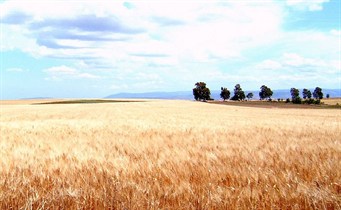The crisis of the seventeenth century and the domination of cereals
 The seventeenth century, the century of the Baroque, was a period of severe demographic and economic crisis for most of Europe. A long series of famines, combined with the spread of epidemics of the plague and other diseases and the proliferation of wars, above of all the Thirty Years’ War, led to a general stagnation of growth of the European population and, in some countries (Germany and Poland), even to a decrease during the entire seventeenth century. With the exception of the British Isles, Scandinavia and the lands of the United Provinces, where economic expansion also generated a growing population, in the rest of the continent, the number of deaths equaled and sometimes exceeded the number of births. In Mediterranean Europe, particularly in Spain and the Spanish Italy, the phenomenon was evident. The plague had already struck Genoa, Catalonia and Castile at the end of the sixteenth century, but it was the following century that saw the most destructive effects of bad harvests, wars, epidemics and famines. Milan, for example, lost 47 percent of its population after the famine of 1628-1629, the plague of 1629-1631 and the effects of the Thirty Years’ War, in which the Duchy of Milan played a key role. In the middle years of the century, Spain (1647-1651), Sardinia (1652-1656), Genoa and southern Italy (1656-1659) were also affected.
The seventeenth century, the century of the Baroque, was a period of severe demographic and economic crisis for most of Europe. A long series of famines, combined with the spread of epidemics of the plague and other diseases and the proliferation of wars, above of all the Thirty Years’ War, led to a general stagnation of growth of the European population and, in some countries (Germany and Poland), even to a decrease during the entire seventeenth century. With the exception of the British Isles, Scandinavia and the lands of the United Provinces, where economic expansion also generated a growing population, in the rest of the continent, the number of deaths equaled and sometimes exceeded the number of births. In Mediterranean Europe, particularly in Spain and the Spanish Italy, the phenomenon was evident. The plague had already struck Genoa, Catalonia and Castile at the end of the sixteenth century, but it was the following century that saw the most destructive effects of bad harvests, wars, epidemics and famines. Milan, for example, lost 47 percent of its population after the famine of 1628-1629, the plague of 1629-1631 and the effects of the Thirty Years’ War, in which the Duchy of Milan played a key role. In the middle years of the century, Spain (1647-1651), Sardinia (1652-1656), Genoa and southern Italy (1656-1659) were also affected.
Other important social and cultural factors weighed on the lack of growth of the European population in the seventeenth century. The concentration of wealth in the hands of social groups which were unwilling to invest and introduce improvements in the agricultural sector was summed with the increase in agricultural prices, which in the first decades of the seventeenth century favoured, especially in the Mediterranean and Eastern Europe, the predominance of cereal. This dominance increased the risks that a poor harvest could turn into a famine, while the diversification of crops would have represented an effective antidote against damage caused by climate. If it is true that Europe since the nineties of the sixteenth century until the mid-nineteenth century went through a small Ice Age, which caused the advance of glaciers and the slowdown in the maturation process of products such as grapes and wheat (and in the growth of trees), the presence of different types of crops, each with a different degree of resistance to cold, would have reduced the risk of famine. In addition, the predominance of cereal in agriculture led to a reduction in the space intended for breeding and, consequently, a lower production of fertilizer for the fields, already depleted by a chemical cereals. Less farming also meant lower consumption of meat, resulting in a general lowering of the height and the average weight of Europeans. The impoverishment of the soil, lack of technical innovations and the worsening climatic conditions, therefore, caused a significant decrease in crop yields, especially of wheat.
